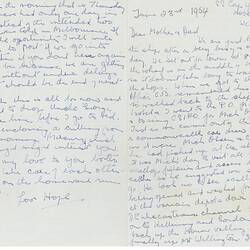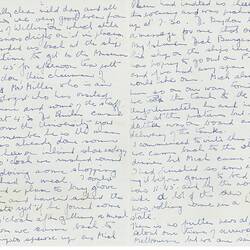Summary
Handwritten letter from Hope Macpherson to her parents detailing life on board ship, SS Cape York, during her expedition with other members from the Nation Museum of Victoria (now Museum Victoria) when they visited Wilsons Promontory and a number of the islands surrounding Tasmania carrying out surveys and collecting specimens, referring specifically to their time in port at Hobart. Hope Macpherson was the first female curator at the National Museum of Victoria (now Museum Victoria).
Description of Content
Colour portrait of Hope Macpherson wearing a knitted top light olive green, collar edged in a lighter colour, pink bow in front on neck line, wearing glasses and not smiling. Image mounted on offwhite backing card that has some foxing.
Physical Description
One sheet grey writing paper folded in half and newspaper cutting headed Scientists To Study Marine Life.
Significance
The Hope (Macpherson) Black Collection is a significant addition to Museum Victoria's working lives collection, it reveals the journey of a woman from depression era Melbourne and illustrates the power of education. It also reveals the often discriminatory policies in place in Victoria before the equal opportunity developments of the late 20th century. In balance though it also exposes the somewhat free expression possible for empowered women in this period. Hope Macpherson clearly states that in her day to day work she never felt discrimination and believes she was given great opportunity to pursue her career and aspirations. However, on analysis her role was often shaped by her gender and its perceived strengths and weaknesses; she was dissuaded from applying to become a taxidermist as it was 'an unsuitable job for a woman', although part of the first group of female scientists allowed to travel to Macquarie Island they were not permitted to camp on land with the male crew for fear of inciting passions. And finally after a distinguished career she was forced to resign her tenure as Australia's first female Curator when she married late in life, as a consequence of the Marriage bar.
More Information
-
Collection Names
-
Collecting Areas
-
Acquisition Information
Donation from Hope Black (nee Macpherson), Apr 2011
-
Sender
Miss Hope Macpherson - National Museum of Victoria, Australia, 23 Jun 1954
-
Addressed To
Jessie Macpherson, Glen Iris, Victoria, Australia, 23 Jun 1954
-
Addressed To
Cluny Macpherson, Glen Iris, Victoria, Australia, 23 Jun 1954
-
Inscriptions
Four page letter handwritten in blue ink on grey writing paper folded in half, together with a newspaper cutting headed Scientists To Study Marine Life noting the three scientists involved in the expedition surveying Tasmania's coastline and collecting specimens, published in the Mercury 25 June 1954. Date June 23rd 1954 handwritten in black ink on top page one.
-
Classification
-
Category
-
Discipline
-
Type of item
-
Overall Dimensions
254 mm (Length), 151 mm (Width)
-
Overall Dimensions
99 mm (Length), 46 mm (Width)
-
Keywords




